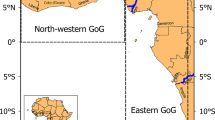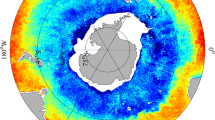Abstract
The temporal and spatial distribution of sea surface salinity (SSS) is not well known in the Arctic region, and only recent satellite-derived measurements and models have allowed for potential enhancement, though their accuracy remains uncertain. We use NASA’s Soil Moisture Active Passive (SMAP) and the European Space Agency’s Soil Moisture Ocean Salinity (SMOS) to investigate the variability of SSS in the Arctic from 2015 to 2017, as well as to calculate surface advective freshwater fluxes. These data sets are compared with Argo and European Center for Medium-Range Weather Forecasts Ocean Reanalysis version 4 (ORAS) to assess the ability of satellites in detecting freshwater fluxes. Salinity and surface freshwater fluxes are estimated for the Bering Strait and Barents Sea Opening (BSO). In this study, we have compared the Jet Propulsion Laboratory’s (JPL) SMAP salinity to the remote sensing system’s (RSS) SMAP salinity product, as well as the The Centre Aval de Traitement des donnéees SMOS salinity product. There is disagreement between the reanalysis product and satellites on the mean and variability of surface freshwater fluxes in the BSO; however, the meridional fluxes of the satellites and reanalysis product were significantly correlated within the Bering Strait. This shows the capability of using satellites to measure surface freshwater fluxes in this pathway. However, the discrepancies between satellite-derived SSS and fluxes in other regions of the Arctic Ocean emphasizes the need to increase in situ monitoring to help validate satellites in the higher latitudes.









Similar content being viewed by others
References
Aagaard K, Carmack EC (1989) The role of sea-ice and other freshwater in the Arctic circulation. J Geophys Res 94(C10):14485–14498. https://doi.org/10.1029/JC094iC10p14485
Aagaard K, Weingartner TJ, Danielson SL, Woodgate RA, Johnson GC, Whitledge TE (2006) Some controls on flow and salinity in Bering Strait. J Geophys Res Lett 33(19). https://doi.org/10.1029/2006GL026612
Armitage TWK, Bacon S, Ridout AL, Thomas SF, Aksenov Y, Wingham DJ (2016) Arctic Sea surface height variability and change from satellite radar altimetry from GRACE, 2003-2014. J. Geophys. Res.: Oceans 121(6):4303–4322. https://doi.org/10.1002/2015JC011579
Balmaseda MA, Mogensen K, Weaver AT (2013) Evaluation of the ECMWF Ocean reanalysis ORAS4. Q J R Meteorol Soc 139(674):1132–1161. https://doi.org/10.1002/qj.2063
Bamber J, van den Broeke M, Ettema J, Lenaerts J, Rignot E (2012) Recent large increases in freshwater fluxes from Greenland into the North Atlantic. Geophys Res Lett 39(19). https://doi.org/10.1029/2012GL052552
Bintanja R, Selten FM (2014) Future increases in Arctic precipitation linked to local evaporation and sea-ice retreat. Nature 509:479–482. https://doi.org/10.1038/nature13259
Boutin J, Jean-Luc V, and Dmitry K (2018a) SMOS SSS L3 maps generated by CATDS CEC LOCEAN. Debias V3.0. SEANOE. https://doi.org/10.17882/52804#57467
Boutin J, Vergely JL, Marchand S, D'Amico F, Hasson A, Kolodziejczyk N, Reul N, Reverdin G, Vialard J (2018b) New SMOS Sea surface salinity with reduced systematic errors and improved variability. Remote Sens Environ 214(1):115–134. https://doi.org/10.1016/j.rse.2018.05.022
Brucker L, Dinnat EP, Koenig LS (2014a) Weekly gridded Aquarius L-band radiometer/scatterometer observations and salinity retrievals over the polar regions—part 1: product description. Cryosphere 8:905–913. https://doi.org/10.5194/tc-8-905-2014
Brucker L, Dinnat EP, Koenig LS (2014b) Weekly gridded Aquarius L-band radiometer/scatterometer observations and salinity retrievals over the polar regions—part 2: initial product analysis. Cryosphere 8:915–930. https://doi.org/10.5194/tc-8-915-2014
Coachman LK, Aagaard K (1981) Re-evaluation of water transports in the vicinity of Bering Strait. In: Hood DW, Calder JA (eds) The eastern Bering Sea shelf: oceanography and resources, vol. 1. National Oceanic and Atmospheric Administration, Washington., pp 95–110
Dickson R, Rudels B, Dye S, Karcher M, Meincke J, Yashayaev I (2007) Current estimates of freshwater flux through Arctic and subarctic seas. Prog Oceanogr 73(3–4):210–230. https://doi.org/10.1016/j.pocean.2006.12.003
Fore AG, Yueh SH, Tang W, Stiles BW, Hayashi AK (2016) Combined active/passive retrievals of ocean vector wind and sea surface salinity with SMAP. IEEE Trans Geosci Remote Sens 54(12):7396–7404. https://doi.org/10.1109/TGRS.2016.2601486
Garcia-Eidell C, Comiso JC, Dinnat E, Brucker L (2017) Satellite observed salinity distributions at high latitudes in the northern hemisphere: a comparison of four products. J. Geophys. Res.: Oceans 122(9):7717–7736. https://doi.org/10.1002/2017JC013184
Haine TWN, Curry B, Gerdes R, Hansen E, Karcher M, Lee C, Rudels B et al (2015) Arctic freshwater export: status, mechanisms, and prospects. Glob Planet Chang 125:13–35. https://doi.org/10.1016/j.gloplacha.2014.11.013
Hawkins E, Smith RS, Allison LC, Gregory JM, Woollings TJ, Pohlmann H, de Cuevas B (2011) Bistability of the Atlantic overturning circulation in a global climate model and links to ocean freshwater transport. Geophys Res Lett 38(10). https://doi.org/10.1029/2011GL047208
JPL Climate Oceans and Solid Earth group (2018) JPL SMAP Level 3 CAP sea surface salinity standard mapped image monthly V4.0 Validated Dataset. Ver. 4.0. PO.DAAC, CA, USA. Dataset accessed [2018-08-20] at https://doi.org/10.5067/SMP40-3TMCS
Klein LA, Swift CT (1977) An improved model for the dielectric constant of seawater at microwave frequencies. IEEE J Ocean Eng 2(1):104–111. https://doi.org/10.1109/JOE.1977.1145319
Lang R, Zhou Y, Utku C, Vine DL (2016) Accurate measurements of the dielectric constant of seawater at L band. Radio Sci 51(1):2–24. https://doi.org/10.1002/2015RS005776
Lique C, Treguier AM, Scheinert M, Penduff T (2009) A model-based study of ice and freshwater transport variability along both sides of Greenland. Clim Dyn 33(5):685–705. https://doi.org/10.1007/s00382-008-0510-7
Lu S, Li H, Xu J, Liu Z, Wu X, Sun C, and Cao M (2018) Manual of Global Ocean Argo gridded data set (BOA_Argo) (Version 2018), 13 pp.
Mazloff MR, Heimbach P, Wunsch C (2010) An eddy-permitting Southern Ocean state estimate. J. Phys Oceanogr 40:880–899. https://doi.org/10.1175/2009JPO4236.1
Meissner T, and Wentz FJ (2016) Remote sensing systems SMAP Ocean surface salinities, version 2.0 validated release. Remote sensing systems, Santa Rosa
Meissner T, and Wentz FJ (2018) Remote sensing Sytems SMAP Ocean surface salinities, version 3.0 validated release. Remote sensing systems, Santa Rosa
Mogensen K, Balmaseda MA, Weaver A (2012) The NEMOVAR Ocean data assimilation system as implemented in the ECMWF Ocean analysis for System4. ECMWF, 668, https://www.ecmwf.int/node/11174
Münchow A, Melling H, Falkner KK (2006) An observational estimate of volume and freshwater flux leaving the Arctic Ocean through Nares Strait. J Physical Oceanography:2025–2041. https://doi.org/10.1175/JPO2962.1
Nyadjro ES, Subrahmanyam B, Shriver JF (2011) Seasonal variability of salt transport during the Indian Ocean monsoons. J. Geophys. Res.: Oceans 116(C8). https://doi.org/10.1029/2011JC006993
Rahmstorf S (1995) Bifurcations of the Atlantic thermohaline circulation in response to changes in the hydrological cycle. Nature 378:145–149. https://doi.org/10.1038/378145a0
Remote Sensing Systems (RSS). 2018. RSS SMAP Level 3 sea surface salinity standard mapped image 8-day running mean V3.0 70km validated dataset. Ver. 3.0. PO.DAAC, CA, USA. Dataset accessed [2018-11-16] at https://doi.org/10.5067/SMP3A-3SPCS
Ricker R, Hendricks S, Girard-Ardhuin F, Kaleschke L, Lique C, Tian-Kunze X, Nicolaus M et al (2017) Satellite-observed drop of Arctic Sea ice growth in winter 2015-2016. Geophys Res Lett 44(7):3236–3245. https://doi.org/10.1002/2016GL072244
Schauer U, Loeng H, Rudels B, Ozhigin VK, Dieck W (2002) Atlantic water flow through the Barents and Kara seas. Deep Sea Res. Part 1: Oceanographic Res Papers 49(12):2281–2298. https://doi.org/10.1016/S0967-0637(02)00125-5
Schmitt RW (2008) Salinity and the global water cycle. Oceanography 21(1):12–19. https://doi.org/10.5670/oceanog.2008.63
Schmitt RW, Bogden PS, Dorman CE (1989) Evaporation minus precipitation and density fluxes for the North Atlantic. J Phys Oceanogr 19:1208–1221. https://doi.org/10.1175/1520-0485(1989)019<1208:EMPADF>2.0.CO;2
Serreze MC, Barrett AP, Slater AG, Woodgate RA, Aagaard K, Lammers RB, Steele M et al (2006) The large-scale freshwater cycle of the Arctic. J. Geophys. Res.: Oceans 111(C11) https://doi.org/10.1029/2005JC003424
Tang W, Yueh SH, Fore AG, Hayashi A (2014) Validation of Aquarius sea surface salinity with in situ measurements from Argo floats and moored buoys. J. Geophys. Res.: Oceans 119(9):6171–6189. https://doi.org/10.1002/2014JC010101
Tang W, Fore A, Yueh S, Lee T, Hayashi A, Sanchez-Franks A, Martinez J et al (2017) Validating SMAP SSS with in situ measurements. Remote Sens Environ 200:326–340. https://doi.org/10.1016/j.rse.2017.08.021
Tang W, Yueh S, Yang D, Fore A, Hayashi A, Lee T, Fournier S et al (2018) The potential and challenges of using soil moisture active passive (SMAP) sea surface salinity to monitor Arctic Ocean freshwater changes. Remote Sens. 10(6):869. https://doi.org/10.3390/rs10060869
Widell K, Fer I, Haugan PM (2006) Salt release from warming sea ice. Geophys Research Lett 33(12). https://doi.org/10.1029/2006GL026262
Woodgate RA, Aagaard K (2005) Revising the Bering Strait freshwater flux into the Arctic Ocean. Geophys Res Lett 32(2). https://doi.org/10.1029/2004GL021747
Acknowledgments
JPL SMAP data is produced by Jet Propulsion Laboratory, and version 4.0 is obtained from NASA JPL PO.DAAC Drive (https://podaac-tools.jpl.nasa.gov/drive/files/allData/smap/retired/L3/JPL/V4/monthly) (doi: https://doi.org/10.5067/SMP40-3TMCS). RSS SMAP data is produced by Remote Sensing Systems and obtained from NASA JPL PO.DAAC Drive (https://podaac-tools.jpl.nasa.gov/drive/files/SalinityDensity/smap/L3/RSS/V3/monthly/SCI/70KM) (DOI: https://doi.org/10.5067/SMP3A-3SPCS). The L3_DEBIAS_LOCEAN_v3 Sea Surface Salinity maps have been produced by LOCEAN/IPSL (UMR CNRS/UPMC/IRD/MNHN) laboratory and ACRI-st company that participate to the Ocean Salinity Expertise Center (CECOS) of Centre Aval de Traitement des Donnees SMOS (CATDS). This product is distributed by the Ocean Salinity Expertise Center (CECOS) of the CNES-IFREMER Centre Aval de Traitement des Donnees SMOS (CATDS), at IFREMER, Plouzane (France) (http://www.catds.fr/Products/Available-products-from-CEC-OS/CEC-Locean-L3-Debiased-v3). AVISO sea surface height is obtained from Copernicus (http://marine.copernicus.eu/services-portfolio/access-to-products/?option=com_csw&view=details&product_id=SEALEVEL_GLO_PHY_L4_REP_OBSERVATIONS_008_047). ORAS4 is produced by ECMWF (ftp://ftp-icdc.cen.uni-hamburg.de/EASYInit/ORA-S4/). We are thankful for the helpful comments of the editor and two anonymous reviewers, which improved the quality of this paper.
Author information
Authors and Affiliations
Corresponding author
Additional information
Publisher’s Note
Springer Nature remains neutral with regard to jurisdictional claims in published maps and institutional affiliations.
Rights and permissions
About this article
Cite this article
Nichols, R.E., Subrahmanyam, B. Estimation of Surface Freshwater Fluxes in the Arctic Ocean Using Satellite-Derived Salinity. Remote Sens Earth Syst Sci 2, 247–259 (2019). https://doi.org/10.1007/s41976-019-00027-5
Received:
Revised:
Accepted:
Published:
Issue Date:
DOI: https://doi.org/10.1007/s41976-019-00027-5




